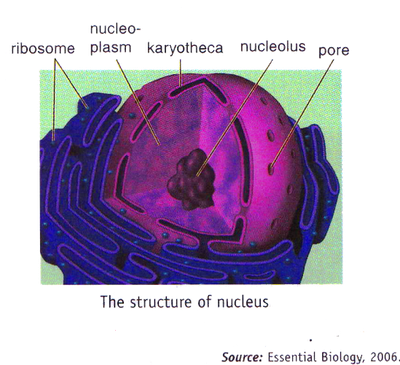Structure And Function Of Organelle Nucleus
Jumat, 17 Agustus 2012
1 Komentar
Nucleus is largest organelle with diameter of 5 um. Its shape varies from around to oval. Nucleus is covered by nucleic membrane or karyote expect in human red blood cell and phloem cell. In prokaryotic cell, the nucleus is not protected by nucleic membrane.
Generally, every cell has one nucleus except on cell of particular organism, such as paramecium and striated muscle.
Nucleus is very vital organelle because it controls all cell activities and contains genetic information, the DNA (deoxyribonucleic acid).
Nucleus consist of nuclear membrane (karyotheca), matrix (nucleoplasm), and daughter nucleus (nucleolus)
- Nuclear membrane (karyotheca) : Karyotheca consist ot two membrane layers that fuction as cover and protector of nucleus. The membrane is related directly to endoplasmic reticulum. In karyotheca, there are pores which allow substance exchange between nucleic plasma and cytoplasm.
- Matrix (nucleoplasm): Nucleoplasm is nucleic liquid in the form of gel enriched with chemical matter, such as ions, proteins, enzymes, nucleotide, and chromatin. Chromatin especially consist of DNA strands. The chromatin that shortens, thickens and is able to absord clor substances during cell division is called chromosome.
- Nucleolus : Nucleolus contains a lot of DNA that functions as nucleic organisator. The main function of nucleolus is to synthesize RNA. So, nucleous also plays role indirectly in protein synthesis.
Source: Essential Biology 2006

luz y Creative Biolabs provides high quality LUZ-Y BsAb generation service to assist your bispecific antibody development.
BalasHapus